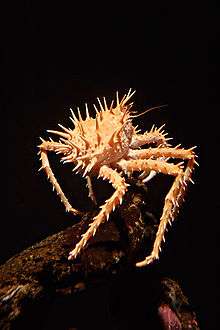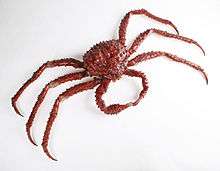King crab
| King crabs | |
|---|---|
 | |
| Paralithodes californiensis | |
| Scientific classification | |
| Kingdom: | Animalia |
| Phylum: | Arthropoda |
| Subphylum: | Crustacea |
| Class: | Malacostraca |
| Order: | Decapoda |
| Infraorder: | Anomura |
| Superfamily: | Lithodoidea |
| Family: | Lithodidae Samouelle, 1819 |
| Genera[1] | |
| |
King crabs are a superfamily of crab-like decapod crustaceans chiefly found in cold seas. Because of their large size and the taste of their meat, many species are widely caught and sold as food, the most common being the red king crab, Paralithodes camtschaticus.
King crabs are generally thought to be derived from hermit crab-like ancestors, which may explain the asymmetry still found in the adult forms. This ancestry is supported by several anatomical peculiarities which are present only in king crabs and hermit crabs.[2] Although some doubt still exists about this theory, king crabs are the most widely quoted example of carcinisation among the Decapoda.[2] The evidence for this explanation comes from the asymmetry of the king crab's abdomen, which is thought to reflect the asymmetry of hermit crabs, which must fit into a spiral shell. Although formerly classified among the hermit crabs in the superfamily Paguroidea, king crabs are now placed in a separate superfamily, Lithodoidea.[1] This is not without controversy as there is a widespread consensus in the scientific community that king crabs are derived from hermit crabs and closely related to pagurid hermit crabs, and therefore a separate superfamily in the classification poorly reflects the phylogenetic relationship of this taxon.[2][3]
Species

Around 121 species are known, in 10 genera:[4]
- Cryptolithodes Brandt, 1848
- Cryptolithodes expansus Miers, 1879
- Cryptolithodes sitchensis Brandt, 1853 – umbrella crab
- Cryptolithodes typicus Brandt, 1848 – butterfly crab
- Glyptolithodes Faxon, 1895
- Glyptolithodes cristatipes (Faxon, 1893)
- Lithodes Latreille, 1806
- Lithodes aequispinus J. E. Benedict, 1895 – golden king crab
- Lithodes aotearoa Ahyong, 2010
- Lithodes australiensis Ahyong, 2010
- Lithodes ceramensis Takeda & Nagai, 2004
- Lithodes chaddertoni Ahyong, 2010
- Lithodes confundens Macpherson, 1988
- Lithodes couesi J. E. Benedict, 1895 – scarlet king crab
- Lithodes ferox Filhol, 1885
- Lithodes formosae Ahyong & Chan, 2010
- Lithodes galapagensis Hall & Thatje, 2009
- Lithodes jessica Ahyong, 2010
- Lithodes longispina Sakai, 1971
- Lithodes macquariae Ahyong, 2010
- Lithodes maja (Linnaeus, 1758) – Norway king crab
- Lithodes mamillifer Macpherson, 1988d
- Lithodes mandtii
- Lithodes manningi Macpherson, 1988
- Lithodes megacantha Macpherson, 1991
- Lithodes murrayi Henderson, 1888
- Lithodes nintokuae Sakai, 1976
- Lithodes panamensis Faxon, 1893
- Lithodes paulayi Macpherson & Chan, 2008
- Lithodes rachelae Ahyong, 2010
- Lithodes richeri Macpherson, 1990
- Lithodes robertsoni Ahyong, 2010
- Lithodes santolla (Molina, 1782) – Chilean centolla or Chilean king crab
- Lithodes turkayi Macpherson, 1988
- Lithodes turritus Ortmann, 1892
- Lithodes unicornis Macpherson, 1984
- Lithodes wiracocha Haig, 1974
- Lopholithodes Brandt, 1848
- Lopholithodes foraminatus (Stimpson, 1859) – brown box crab
- Lopholithodes mandtii Brandt, 1848 – Puget Sound king crab
- Neolithodes A. Milne-Edwards & Bouvier, 1894
- Neolithodes agassizii (S. I. Smith, 1882)
- Neolithodes asperrimus Barnard, 1947
- Neolithodes brodiei Dawson & Yaldwyn, 1970
- Neolithodes bronwynae Ahyong, 2010
- Neolithodes capensis Stebbing, 1905
- Neolithodes diomedeae (J. E. Benedict, 1895)
- Neolithodes duhameli Macpherson, 2004
- Neolithodes flindersi Ahyong, 2010
- Neolithodes grimaldii (A. Milne-Edwards & Bouvier, 1894)
- Neolithodes nipponensis Sakai, 1971
- Neolithodes vinogradovi Macpherson, 1988
- Neolithodes yaldwyni Ahyong & Dawson, 2006
- Paralithodes Brandt, 1848
- Paralithodes brevipes (H. Milne Edwards & Lucas, 1841)
- Paralithodes californiensis (J. E. Benedict, 1895) – California king crab
- Paralithodes camtschaticus (Tilesius, 1815) – red king crab
- Paralithodes platypus Brandt, 1850 – blue king crab
- Paralithodes rathbuni (J. E. Benedict, 1895)
- Paralomis White, 1856
- Paralomis aculeata Henderson, 1888
- Paralomis africana Macpherson, 1982
- Paralomis alcockiana Hall & Thatje, 2009
- Paralomis anamerae Macpherson, 1988
- Paralomis arae Macpherson, 2001
- Paralomis arethusa Macpherson, 1994
- Paralomis aspera Faxon, 1893
- Paralomis birsteini Macpherson, 1988
- Paralomis bouvieri Hansen, 1908
- Paralomis ceres Macpherson, 1989
- Paralomis chilensis Andrade, 1980
- Paralomis cristata Takeda & Ohta, 1979
- Paralomis cristulata Macpherson, 1988
- Paralomis cubensis Chace, 1939
- Paralomis danida Takeda & Bussarawit, 2007
- Paralomis dawsoni Macpherson, 2001
- Paralomis diomedeae (Faxon, 1893)
- Paralomis dofleini Balss, 1911
- Paralomis echidna Ahyong, 2010
- Paralomis elongata Spiridonov, Türkay, Arntz & Thatje, 2006
- Paralomis erinacea Macpherson, 1988
- Paralomis formosa Henderson, 1888
- Paralomis gowlettholmes Ahyong, 2010
- Paralomis granulosa (Hombron & Jacquinot, 1846)
- Paralomis grossmani Macpherson, 1988
- Paralomis haigae Eldredge, 1976
- Paralomis hirtella de Saint Laurent & Macpherson, 1997
- Paralomis histrix (De Haan, 1849)
- Paralomis hystrixoides Sakai, 1980
- Paralomis inca Haig, 1974
- Paralomis indica Alcock & Anderson, 1899
- Paralomis investigatoris Alcock & Anderson, 1899
- Paralomis jamsteci Takeda & Hashimoto, 1990
- Paralomis japonicus Balss, 1911
- Paralomis kyushupalauensis Takeda, 1985
- Paralomis longidactylus Birstein & Vinogradov, 1972
- Paralomis longipes Faxon, 1893
- Paralomis makarovi Hall & Thatje, 2009
- Paralomis manningi Williams, Smith & Baco, 2000
- Paralomis medipacifica Takeda, 1974
- Paralomis mendagnai Macpherson, 2003
- Paralomis microps Filhol, 1884
- Paralomis multispina (Benedict, 1895)
- Paralomis nivosa Hall & Thatje, 2009
- Paralomis ochthodes Macpherson, 1988
- Paralomis odawarai (Sakai, 1980)
- Paralomis otsuae Wilson, 1990
- Paralomis pacifica Sakai, 1978
- Paralomis papillata (Benedict, 1895)
- Paralomis pectinata Macpherson, 1988
- Paralomis phrixa Macpherson, 1992
- Paralomis poorei Ahyong, 2010
- Paralomis roeleveldae Kensley, 1981
- Paralomis seagranti Eldredge, 1976
- Paralomis serrata Macpherson, 1988
- Paralomis spectabilis Hansen, 1908
- Paralomis spinosissima Birstein & Vinogradov, 1972
- Paralomis staplesi Ahyong, 2010
- Paralomis stella Macpherson, 1988
- Paralomis stevensi Ahyong & Dawson, 2006
- Paralomis taylorae Ahyong, 2010
- Paralomis truncatispinosa Takeda & Miyake, 1980
- Paralomis tuberipes Macpherson, 1988
- Paralomis verrilli (Benedict, 1895)
- Paralomis webberi Ahyong, 2010
- Paralomis zealandica Dawson & Yaldwyn, 1971
- Phyllolithodes Brandt, 1848
- Phyllolithodes papillosus Brandt, 1848 – flatspine triangle crab, heart crab
- Rhinolithodes Brandt, 1848
- Rhinolithodes wosnessenskii Brandt, 1848 – rhinoceros crab
- Sculptolithodes Makarov, 1934
- Sculptolithodes derjugini Makarov, 1934
Glyptolithodes
Glyptolithodes is found chiefly in the Southern Hemisphere, but extending as far north as California, although all its closest relatives live in the Northern Hemisphere. Its single species, G. cristatipes was originally placed in the genus Rhinolithodes.
Neolithodes
Neolithodes yaldwini
In 2011, scientists found Neolithodes yaldwini on the edge of Antarctica, probably as a result of global warming, with major impacts on sediment texture, bioturbation and local faunal diversity.[5][6]
Paralithodes
Red (P. camtschaticus) and blue (P. platypus) king crabs are some of the most important fisheries in Alaska, however populations have fluctuated in the past 25 years and some areas are currently closed due to overfishing. The two species are similar in size, shape and life history.[7][8][9] Habitat is the main factor separating the range of blue and red king crabs in the Bering Sea.[10] Red king crabs prefer shallow, muddy or sandy habitats in Bristol Bay and Norton Sound,[10][11] while blue king crabs prefer the deeper areas made up of cobble, gravel and rock that occur around the Pribilof, St. Matthew,[12][13] St. Lawrence and the Diomede Islands.
Red king crabs have an 11-month brood cycle in their first reproductive year and a 12-month cycle thereafter.[9] Both red and blue king crabs have planktotrophic larvae that undergo 4 zoeal stages in the water column and a non-feeding, glaucothoe stage which is an intermediate stage which seeks appropriate habitat on the sea floor.

Paralithodes camtschaticus
The red king crab, Paralithodes camtschaticus, is a very large species, sometimes reaching a carapace width of 11 in (28 cm) and a leg span of 6 ft (1.8 m). Its natural range is the Bering Sea around the Kamchatka Peninsula area, between the Aleutian Islands and St. Lawrence Island. It can now also be found in the Barents Sea and the European Arctic, where it was intentionally introduced and is now becoming a pest.[14][15]
Paralithodes platypus
The blue king crab, Paralithodes platypus, lives near St. Matthew Island, the Pribilof Islands, and the Diomede Islands, Alaska, and there are populations along the coasts of Japan and Russia.[13] Blue king crabs from the Pribilof Islands are the largest of all the king crabs, sometimes exceeding 18 lb (8 kg) in weight.[16]
See also
References
- 1 2 Sammy De Grave; N. Dean Pentcheff; Shane T. Ahyong; et al. (2009). "A classification of living and fossil genera of decapod crustaceans" (PDF). Raffles Bulletin of Zoology. Suppl. 21: 1–109.
- 1 2 3 Jonas Keiler; Stefan Richter; Christian S. Wirkner (2013). "Evolutionary morphology of the hemolymph vascular system in hermit and king crabs (Crustacea: Decapoda: Anomala)". Journal of Morphology. 274 (7): 759–778. doi:10.1002/jmor.20133.
- ↑ Arthur Anker; Gustav Paulay (2013). "A remarkable new crab-like hermit crab (Decapoda: Paguridae) from French Polynesia, with comments on carcinization in the Anomura." (PDF). Zootaxa. 3722 (2): 283–300. doi:10.11646/zootaxa.3722.2.9.
- ↑ Patsy A. McLaughlin; Tomoyuki Komai; Rafael Lemaitre; Dwi Listyo Rahayu (2010). Martyn E. Y. Low; S. H. Tan, eds. "Annotated checklist of anomuran decapod crustaceans of the world (exclusive of the Kiwaoidea and families Chirostylidae and Galatheidae of the Galatheoidea)" (PDF). Zootaxa. Suppl. 23: 5–107.
|chapter=ignored (help) - ↑ Craig R. Smith; Laura J. Grange; David L. Honig; Lieven Naudts; Bruce Huber; Lionel Guidi; Eugene Domack (2011). "A large population of king crabs in Palmer Deep on the west Antarctic Peninsula shelf and potential invasive impacts". Proceedings of the Royal Society B: Biological Sciences. 279: 1017. doi:10.1098/rspb.2011.1496.
- ↑ Richard Black (September 6, 2011). "Giant crabs make Antarctic leap". BBC News.
- ↑ G. C. Jensen; D. A. Armstrong (1989). "Biennial reproductive cycle of blue king crab, Paralithodes platypus, at the Pribilof Islands, Alaska and comparison to a congener Paralithodes camtschatica". Canadian Journal of Fisheries and Aquatic Sciences. 46 (6): 932–940. doi:10.1139/f89-120.
- ↑ A. K. Klitin; S. A. Nizyaev (1999). "The distribution and life strategies of some commercially important Far Eastern lithodid crabs in the Kuril Islands". Biologiya Morya. Vladivostok. 25 (3): 221–228.
- 1 2 B. G. Stevens; K. M. Swiney (2006). "Timing and duration of larval hatching for blue king crab Paralithodes platypus Brandt, 1850 held in the laboratory" (PDF). Journal of Crustacean Biology. 26 (4): 495–502. doi:10.1651/S-2677.1.
- 1 2 North Pacific Fishery Research Council (2005). "Essential Fish Habitat Assessment Report for the Bering Sea and Aleutian Islands King and Tanner Crabs" (PDF). NOAA Fisheries Report.
- ↑ J. Soong; T. Kohler (2005). Norton Sound Winter Red King Crab Studies (PDF). Fisheries Data Series. Alaska Department of Fish and Game.
- ↑ J. Zheng; M. C. Murphy; et al. (1997). "Application of a catch-survey analysis to blue king crab stocks near Pribilof and St. Matthew Islands" (PDF). Alaska Fishery Research Bulletin. 4 (1): 62–74.
- 1 2 Ivan Vining; S. Forrest Blau; Doug Pengilly (2001). "Evaluating changes in spatial distribution of blue king crab near St. Matthew Island". In Gordon H. Kruse; Nicolas Bez; Anthony Booth; Martin W. Dorn; Sue Hills; Romuald N. Lipcius; Dominique Pelletier; Claude Roy; Stephen J. Smith; David Witherell. Spatial processes and management of marine populations (PDF). University of Alaska Sea Grant College Program Report. pp. 327–348. ISBN 978-1-56612-068-5.
- ↑ Lars Bevanger (August 9, 2006). "Norway fears giant crab invasion". BBC News.
- ↑ Alex Kirby (September 29, 2003). "King crabs march towards the Pole". BBC News.
- ↑ "King Crab 101". Fisherman's Express. 2000.
External links
 Media related to Lithodidae at Wikimedia Commons
Media related to Lithodidae at Wikimedia Commons Data related to Lithodidae at Wikispecies
Data related to Lithodidae at Wikispecies